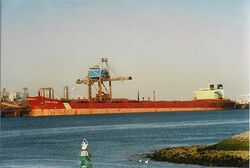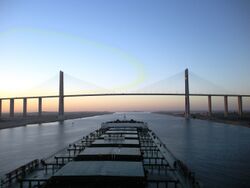Engineering:Capesize
Capesize ships are the largest dry cargo ships with ball mark dimension:[lower-roman 1] about 170,000 DWT (deadweight tonnage) capacity, 290 m long, 45 m beam (wide), 18m draught (under water depth).[1] They are too large to transit the Suez Canal (Suezmax limits) or Panama Canal (Neopanamax limits),[2] and so have to pass either Cape Agulhas or Cape Horn to traverse between oceans.
When the Suez Canal was deepened in 2009, it became possible for some capesize ships to transit the canal and so change categories.
Routes
Major capesize bulk trade routes include: Brazil to China, Australia to China, South Africa to China and South Africa to Europe.[3]
Classification

Ships in this class are bulk carriers, usually transporting coal, ore and other commodity raw materials. The term capesize is not applied to tankers. The average size of a capesize bulker is around 156,000 DWT, although larger ships (normally dedicated to ore transportation) have been built, up to 400,000 DWT.[5] The large dimensions and deep drafts of such vessels mean that only the largest deep-water terminals can accommodate them.[6]
Subcategories of capesize vessels include very large ore carriers (VLOC) and very large bulk carriers (VLBC) of above 200,000 DWT. These vessels are mainly designed to carry iron ore.
See also
- Cape Route
- List of Panamax ports
- Cargo ship size categories
- Suezmax
References
- ↑ Measured in relation to the Plimsoll line and the Plimsoll disc or 'ball mark'.
- ↑ "Types of vessel sizes and Bulk Carriers - A One Maritime". https://aone-maritime.com/vessel-sizes/.
- ↑ Clark, Iain J. (2014-02-19). Commodity Option Pricing: A Practitioner's Guide. Wiley. pp. 267–. ISBN 9781444362404. https://books.google.com/books?id=NifnAgAAQBAJ&pg=PA267. Retrieved 11 April 2014.
- ↑ "What is the Baltic Dry Index?". https://corporatefinanceinstitute.com/resources/knowledge/other/baltic-dry-index/.
- ↑ STRICKEN Ship Will be Biggest At Inchgreen Berth For Decades , Inverclyde Now 28 February 2014
- ↑ "YUAN JIN HAI - Dry bulk / Ultra Cape - IMO 9806914" (in en). https://maritimeoptima.com/public/vessels/pages/imo:9806914/mmsi:563072400/YUAN_JIN_HAI.html.
- ↑ "Modern ship size definitions". Lloyd's Register. Jan 3, 2014. Archived from the original on December 26, 2014. https://web.archive.org/web/20141226162404/http://www.lr.org/en/_images/213-35657_30-ship-sizes.pdf. Retrieved April 23, 2015..
External links
 |



